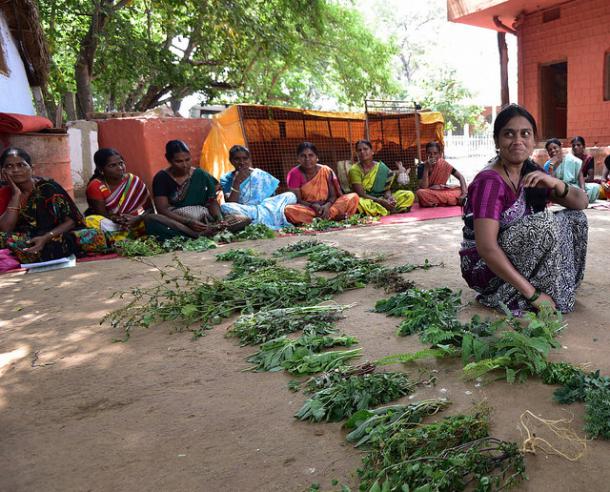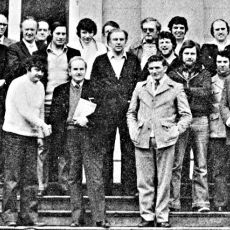Seeding an Agrarian Revolution in Rural India
Aided by a local nonprofit, marginalized women farmers are growing a rich harvest of crops using age-old farming traditions.
Her farm looks like a mini rainforest, with a profusion of crops from ground level up to way above our heads. The diversity of species and varieties is bewildering. There’s an array of jowar (sorghum or great millet), bajra (pearl millet), ragi (finger millet), red gram, green gram, til (sesame), sama (little millet), korra (foxtail millet), and a wide variety of vegetables and fruits. As we walk through this explosion of life, trying hard to avoid stepping on plants that would yield something precious, Nadimidoddi Vinodamma, softly explains her farming techniques and philosophy.
Nadimidoddi Vinodamma surrounded by jowar (sorghum) varieties on her farm. Vinodamma — who belongs to India’s most oppressed social category called Dalits (also known as the “untouchables,” or “Harijans”) — has turned on its head the logic of the so-called Green Revolution.
“I’m merely using knowledge handed down over generations, trusting the land and traditional seeds,” she says.
We are in Nagwar village, near Zaheerabad in the southern Indian state of Telangana, one of the nation’s driest regions. Here, on just three acres of rain fed land, with no chemical input whatsoever, Vinodamma has grown 45 crop varieties, produced enough food to feed her family for the whole year, and earned more than $3,000 selling the surplus produce. This, in a year where the region saw 40 percent less rainfall than normal.
With little fuss, Vinodamma — who belongs to India’s most oppressed social category called Dalits (also known as the “untouchables,” or “Harijans”) — has turned on its head the logic of the so-called Green Revolution.
Ushered into India in the 1960s and still the reigning agricultural strategy in official circles, the Green Revolution hinges on converting “subsistence” farming into commercial production through the use of lab-generated hybrid seeds, chemical fertilizers, pesticides, surface irrigation, and financial credit from the government. The Green Revolution undoubtedly increased crop production in the country, but it has also ruined soils, poisoned water and food (taking cancer levels to new heights in the intensively farmed areas), marginalized already small farmers, created indebtedness and economic desperation that’s driven more than 300,000 farmers to suicide in the past decade, and eroded precious genetic diversity in seeds and livestock breeds.
For decades, we’ve been sold the idea that the Green Revolution is the only way for Indian agriculture to “develop.” Organic, biodiverse agriculture and pastoralism, which was what Indian farmers traditionally practiced, will not feed the country’s growing population, we were told. We are still being told that. It is only when we hear of stories like that of Vinodamma, that we realize these are myths, shouted out as truths by an establishment and corporate entities that want to continue their domination of (not to mention profits from) India’s agriculture and food production systems.
I’m visiting Vinodamma’s farm with some colleagues from Kalpavriksh, an environmental organization that I helped cofound back in the 1990s, after hearing of her remarkable story from the Deccan Development Society (DDS), a local nonprofit that she’s a member of. Continuing with age-old farming traditions is not the only reason for Vinodamma’s success. DDS has been another major factor too. For nearly three decades, the society has quietly worked with Dalit women farmers, all small or marginal landholders, to point the way to food sovereignty, sustainable agriculture, women’s empowerment, and community-led communications.
Her husband Vinayappa also ably helps Vinodamma on the farm. As we walk through their field, Vinodamma and Vinayappa point to five varieties of jowar (sorghum), telling us how one grows quite fast and with very little water (and is therefore called ‘poor person’s jowar’), another is good for diabetics, a third one has high productivity, and so on. They tell us how the harvesting will be staggered over a few weeks, as different crops have different maturing periods.
We ask them if their output this year is enough to feed the family the whole year. “Yes,” says Vinodamma beaming. “plus there is surplus to sell.” The only groceries they need to buy from the market are salt, sugar, coconut oil, soap and detergent, she says, and some vegetables during the February-April period or during drought years.
We notice some trampled jowar and bajra. “That’s been done by wild pigs,” Vinayappa tells us. “They sometimes get into the field, but even after the pigs and birds and other creatures have done their damage or taken their share, there is enough food for the family!” he says.
The couple use only vermicompost, cow dung powder, and dried neem (Azadirachta indica) powder as fertilizers. “What about pests, what do you do when some attack a crop?” we ask. “We spray jaggery (sugarcane extract) water on crops, which attracts ants that will feed on pests,” Vinayappa says, “and we use neem oil and other natural products if there is a greater pest attack. For the last several years, there has been no serious pest problem.”
Noticing that the neighboring farm has only cotton growing in it, we ask why that farmer is not doing what Vinodamma and Vinayappa are. “He was attracted by the incessant advertisements, often featuring famous celebrities, that promise bumper cotton harvests and immediate wealth,” Vinodamma said. “But despite repeated applications of fertilizers and pesticides, his yield this year was so bad, he has suffered a financial loss.”
Is he then attracted to their way of farming, will he switch to millets and pulses? He is definitely dropping cotton next year, Vinodamma replied, but it’s unclear whether he will try out yet another promised miracle with sugarcane, or emulate them.
A collective endeavor
Vinodamma is part of a sangham, a collective of Dalit women of her village that is affiliated with the Deccan Development Society. There are several such sanghams, with a total of about 3,000 women members, in 45 villages in the region. Through seed exchange, fund collection and management, knowledge sharing, collective labor, and other joint activities, the sanghams have overcome the barriers and limitations that each individual marginal woman farmer faces and helps them take back control over their lives.
As the umbrella organization, DDS assists the farmers in many ways including, helping them get loans, connecting them to banks, conducting participatory natural resource documentation and planning exercises, trying to get women ownership over, or rights to, lands they are cultivating, dealing with hostile or indifferent government officials and building relationships with helpful ones, providing information on the dangers of chemical fertilizers, pesticides and genetically modified seeds, and marketing the farmers’ organic produce through a cooperative called Sangham Organics.
DDS has also been trying to get the area it operates in declared a Biodiversity Heritage Site, a status under India’s Biological Diversity Act 2003, that could provide the move towards sustainable farming greater security. Though the legal specifics are unclear, such a status could perhaps be used to check the entry or spread of genetically modified crops here (Bt Cotton is already being grown here, and the Society has actively documented it ill-effects). Unfortunately the State Biodiversity Board has been delaying making a decision on this.
The demand for a Biodiversity Heritage Site status is partly an outcome of DDS’s involvement with other nationwide environmental networks and grassroots agricultural campaigns that are working to democratize biodiversity management and facilitate local, community-centered natural resource and biodiversity conservation initiatives across the country. One of these was a widely participatory national process of formulating India’s National Biodiversity Strategy and Action Plan, in the early 2000s.
It was as part of this process that DDS introduced the idea of biodiversity festivals in the late 1990s, which has since spread to many parts of India. The society still organizes a month-long mobile festival every January-February, which features wonderfully decorated bullock carts that display a selection of local seeds and traditional dishes, and includes discussions in dozens of villages about the importance of organic, sustainable, biodiverse farming, and the dangers of corporate control over food. These processes, and the sheer weight of the success of farmers like Vinodamma, are also used for advocacy at district, state, and national government levels.
One of DDS’s most important innovations is the parallel “Public Distribution System” (PDS) it has helped set up. The PDS is a decades-old, government-run program meant to provide access to cheap food grains, kerosene fuel, and other household products to the poor across India. Unfortunately it has so far only supplied poor quality materials and the system is ridden with corruption. (The national movement demanding a Right to Information law was partly spurred by the need to expose the misdeeds of PDS shop managers.) The society’s parallel PDS seeks to offer an alternative to the dysfunctual government program.
Tuljemma, another woman farmer and DDS member, explained how the system works. “Loans given to poor Dalit women farmers by DDS are repaid in kind, by say, a specified quantity of jowar. This jowar is then made available to the poor in each village, at subsidized rates. Not only does this offer econmic relief to the villagers, it also helps localize the food economy to some extent. This example has been used to advocate fundamental changes in the official PDS system across India, including its decentralization (in terms of democratic control) and localization (in terms of diverse foods relevant to local ecologies and cultures). A number of states are now considering such an approach.
The society also runs a local agricultural science center (Krishi Vigyan Kendra) with help from government-appointed scientists, one of the few in India where the curriculum is set by farmers. And to help make the local organic food — especially millet-based products and dishes — more popular, DDS has set up a café and a Sangham Organics shop in Zaheerabad, a town close to Vinodamma’s village.
An all-round revolution
The importance of the model being pioneered by the Dalit women of DDS is manifold. Not only does it help small-scale, marginal farmers achieve food sovereignty and security, it’s also a model most suited to India’s rainfed and dryland landscapes. There are also significant benefits for climate mitigation and adaptation. About 6 percent of India’s emissions come from the production and use of synthetic nitrogen-based fertilizers, which can be completely eliminated with organic biodiverse farming. Besides, a diversity of crops and techniques is more resilient to the vagaries of climate than are monocultural approaches.
The DDS initiative has, in fact, gone way beyond addressing food and agriculture issues. It has facilitated the transformation of the women into filmmakers, community radio managers, teachers, and much more. It helped start India’s first rural community radio station, Sangham Radio, in 2008, as well as a “Community Media Trust” that is run by the women farmers who double up as filmmakers.
All this has dramatically altered the triple marginalized status of Dalit women — as persons of lower caste, as women, and as small farmers — in this region. The respect they have gained within their own communities, and in national and global circles, is palpable. Several DDS members have been able to travel to other parts of India and abroad to showcase their work. Filmmaker and farmer Chinna Narsamma, for instance, has traveled to about 20 countries, showing her films, exchanging experiences with similar grassroots movements across the world. Or 13-year old Masanagari Mayuri, who made a film documenting the wisdom and knowledge of her elders that showed how her family’s farms are like school to her. Such exposure has help give several women the confidence to speak about, not only their crops, soil, and cuisine, but also about the national and global politics of food and agriculture.
Of course, there’s a lot more that needs to be done. One of the things DDS workers lament is the increasing privatization and English-orientation of the local education system that alienates youth from their cultures and ecologies. A holistic revival of India’s rural areas that covers the entire range of people’s needs and aspirations is beyond the scope of any single organization. DDS’s forays beyond agriculture, into media and communications, education, and health are providing partial solutions, but only partial. Despite this, stories of that of Vinodamma and other society members prove that building a healthy and successful livelihood based on ecologically sustainable and culturally rooted processes is possible within a generation.






Comments
Post new comment